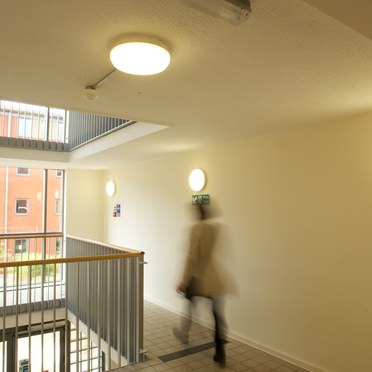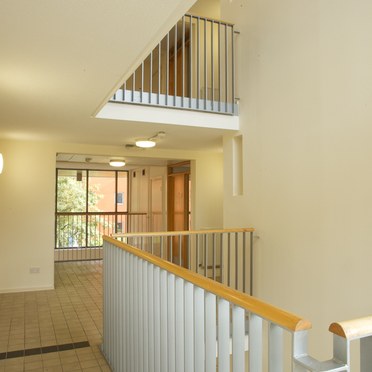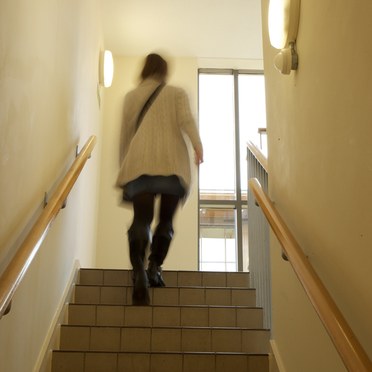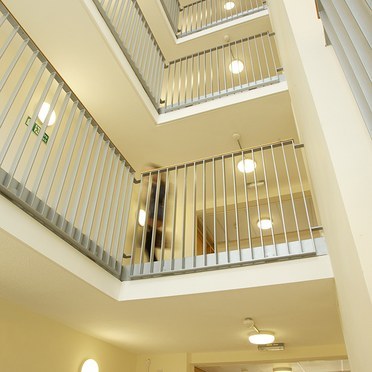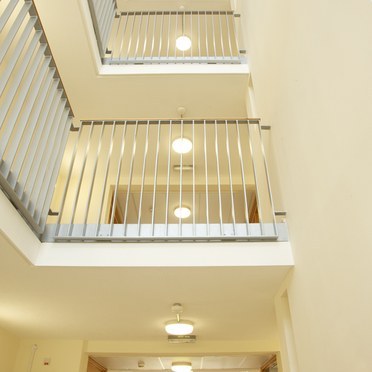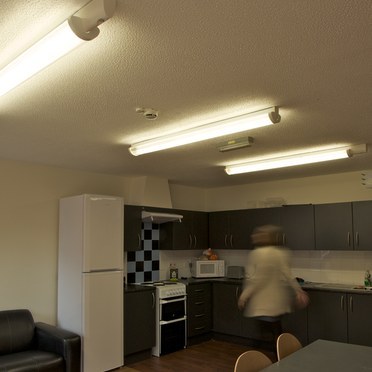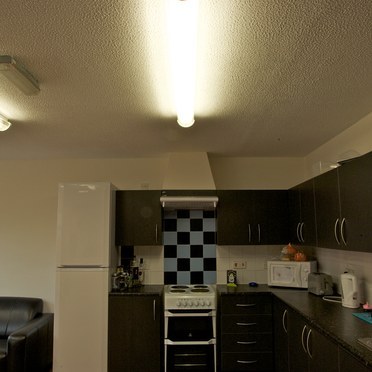University of Lincoln, UK
- Lamp efficacy
Lamp efficacy
Lighting energy consumption reduced by 25% due to LED technology and built-in controls, with total energy consumption in student halls reduced by more than 20%
- Ballast classification
Ballast classification
Controlling the electricity supply to the lamp (Energy Efficiency Index).
- Luminaire distribution
Luminaire distribution
Controlling light emission using optics which bend and shape the light to the correct location.
- System efficacy
System efficacy
Combining optical and thermal control within the luminaire (luminaire lm/W).
- Presence/absence detection
Presence/absence detection
Built in controls ensure lights in common areas and kitchens are never left on by students
- Daylight detection
Daylight detection
Artificial lighting which responds to the natural light conditions.
- Constant illuminance
Constant illuminance
A function designed to produce correct light levels for the duration of the maintenance period.
- Task-scene setting
Task-scene setting
Allowing the user to set scenes and adapt the lighting to different tasks.
- Timed off
Timed off
Automatic cut-off can be installed to turn all lights off during unoccupied hours.
- Task lighting
Task lighting
Lighting task areas with the correct amount of light.
- Zoning of lighting
Zoning of lighting
Lighting is zoned according to area use.
- Maintenance schedule
Maintenance schedule
The new Thorn LED products last five times longer than traditional 2D fluorescents, reducing maintenance workloads and costs.
- Waste light
Waste light
Eliminating waste light which does not hit the intended target.
- Reflectance
Reflectance
Taking advantage of light which is reflected from the surface within the space.
- Visible smart metering
Visible smart metering
Results of actions can be quickly seen as increased or decreased energy use to encourage responsible energy consumption.
University reduces lighting energy consumption by 25% and wins recycling award
The University of Lincoln has deployed state-of-the-art LED and fluorescent lighting from Thorn in 17 student halls, reducing lighting energy consumption and costs by 25%. The university also won the Lux 2013 Recycling Award for disposing of old luminaires and battens in a green way.
Project background
Universities across the UK are updating their facilities to increase energy efficiency and minimise carbon emissions. This is the case at the University of Lincoln, which has climbed more places in the university league table in recent years than almost any other institution in the country.
In 2009, the University of Lincoln published an Environmental Policy document, setting challenging targets for preventing pollution and minimising energy consumption. By 2017, the institution aims to meet Higher Education Funding Council for England (HEFCE) targets for reducing carbon emissions.
In the summer of 2012, the University of Lincoln embarked on a major refurbishment of ‘The Courts’,its complex of 17 student halls of residence with 1,037 furnished bedrooms, common areas and shared kitchens. To ensure that the project supported the university’s environmental goals, the facilities teams went to market for efficient indoor lighting products to replace existing 2D and T26 switchstart fluorescent luminaires and battens.
Phil Lawson, Head of Electrical Projects at the University of Lincoln, says: “We needed LED luminaires and fluorescent battens that were durable, cost effective and simple to install, with no need for major alterations to the existing in-building wiring. Integrated controls were also a must to ensure that students never leave lights on when they leave the room.”
Another key requirement for the project was to dispose of the old luminaires in line with the Waste Electrical and Electronic Equipment (WEEE) directive, recycling materials where possible and minimising waste sent to landfill.
The Thorn solution
While visiting the LuxLive show in 2011, Phil Lawson saw Thorn Lighting’s new Leopard LED bulkhead luminaires and T16 Pop Pack Pro fluorescent battens in action. “I’d already seen LED products and fluorescent battens from other manufacturers, but I needed a guarantee of quality and durability, and that’s what you get from Thorn,” says Phil. “Thorn’s proposal was also extremely competitive from a commercial standpoint, and they were able to provide a solution for recycling our old luminaires as part of the package.”
During the planning phase of the project, the Thorn account team helped the University of Lincoln build a business case for replacing its existing switchstart 2D bulkhead luminaires and T26 battens with the latest Thorn LED and fluorescent products. “Based on a combination of lower energy consumption and automated controls, we were able to calculate that the move to Thorn products would reduce our installed load, meaning our lighting energy consumption, by 23 kilowatts from 57.7 kilowatts to 33.9 kilowatts across all 17 blocks,” says Phil.
With the business case established, the university worked with a Thorn reseller and Thorn recycling partners to replace luminaires across the halls of residence based on a three-phase deployment. “We replaced 1479 luminaires in seven blocks in 2012, a further 1429 luminaires across five blocks in 2013,” says Phil, “and we will upgrade luminaires in the final five blocks in the summer of 2014.”
Following on from each phase, old luminaires and battens were placed in recycling skips provided by Thorn recycling partners Lumicom and Recolight. “The materials were separated into two skips and taken away for recycling,” says Phil.
Results and benefits
By replacing fluorescent luminaires and battens across its student halls with the latest LED and fluorescent products from Thorn, the University of Lincoln is minimising its environmental impact and lowering energy costs. The university will also reduce carbon dioxide emissions by 62%, and gained industry recognition for its commitment to recycling.
University will achieve full returns on investment in five years
Based on a combination of efficient LED and fluorescent technology and integrated controls, the University of Lincoln will achieve rapid returns on its investments in Thorn products. This is based on lighting energy savings of 25% and total energy savings in student blocks of more than 20%. “We’ve been able to measure the difference in energy consumption between five of the blocks that use Thorn’s products, and those that still have the old 2D, switchstart fluorescents,” says Phil. “For those five blocks alone, we are seeing an average monthly energy saving of more than 20%, which means total energy savings of nearly £10,000 for the academic year. If we achieve similar results for the other 12 blocks, our Thorn products will pay for themselves in just five years.”
Industry recognition for environmental best practice
The university won the Lux 2013 Recycling Award for its major refurbishment project at The Courts. “The ability to recycle our old luminaires and battens was always a key priority for this project, and we’re very proud of what we’ve achieved,” says Phil. “Winning the Lux Award shows that we are leading the way when it comes to recycling and environmental responsibility.”
Fast, simple deployment
The new Thorn LED and fluorescent products were fast, simple and cost effective to install in the student halls, with no need for rewiring. In addition, the new luminaires and battens incorporate sensors that ensure they are never left on when students leave the room, and which ensure that lights come on in the event of an emergency – all in the same compact unit. “The Thorn luminaires and battens provide all the functionality we need in a simple product that is very quick and easy to install,” says Phil.
Key Facts
Project background
- Refurbishing 17 student halls of residence and replacing inefficient 2D fluorescent lighting
- Meeting challenging environmental targets for preventing pollution and minimising energy consumption
- Recycling old luminaires and battens to minimise waste sent to landfill
- Harnessing controls to prevent lights being left on in common areas
- Deploying new lights without extensive rewiring work
The Thorn solution
- Thorn Leopard LED Bulkhead luminaires and Pop Pack Pro 35W T5 battens
- Phased, 3-year deployment to replace lights across all 17 student halls
- Recycling of old luminaires and battens by Thorn partners
Results and benefits
- Monthly lighting energy savings of 25% with total energy savings
of more than 20% - Full return on investment in Thorn LED products in five years
- Fast, simple deployment with no rewiring required
- Built in controls and emergency lighting features
- Lux 2013 Recycling Award recognises the university's environmental leadership
- Maintenance workloads and costs reduced by a factor of five
- Partnership based on close, trust-based working relationships and excellent service

